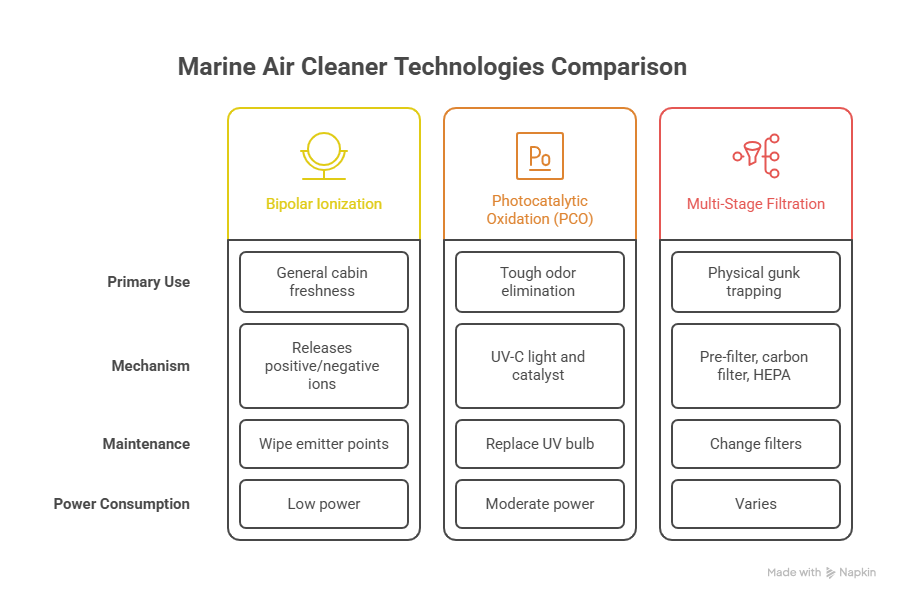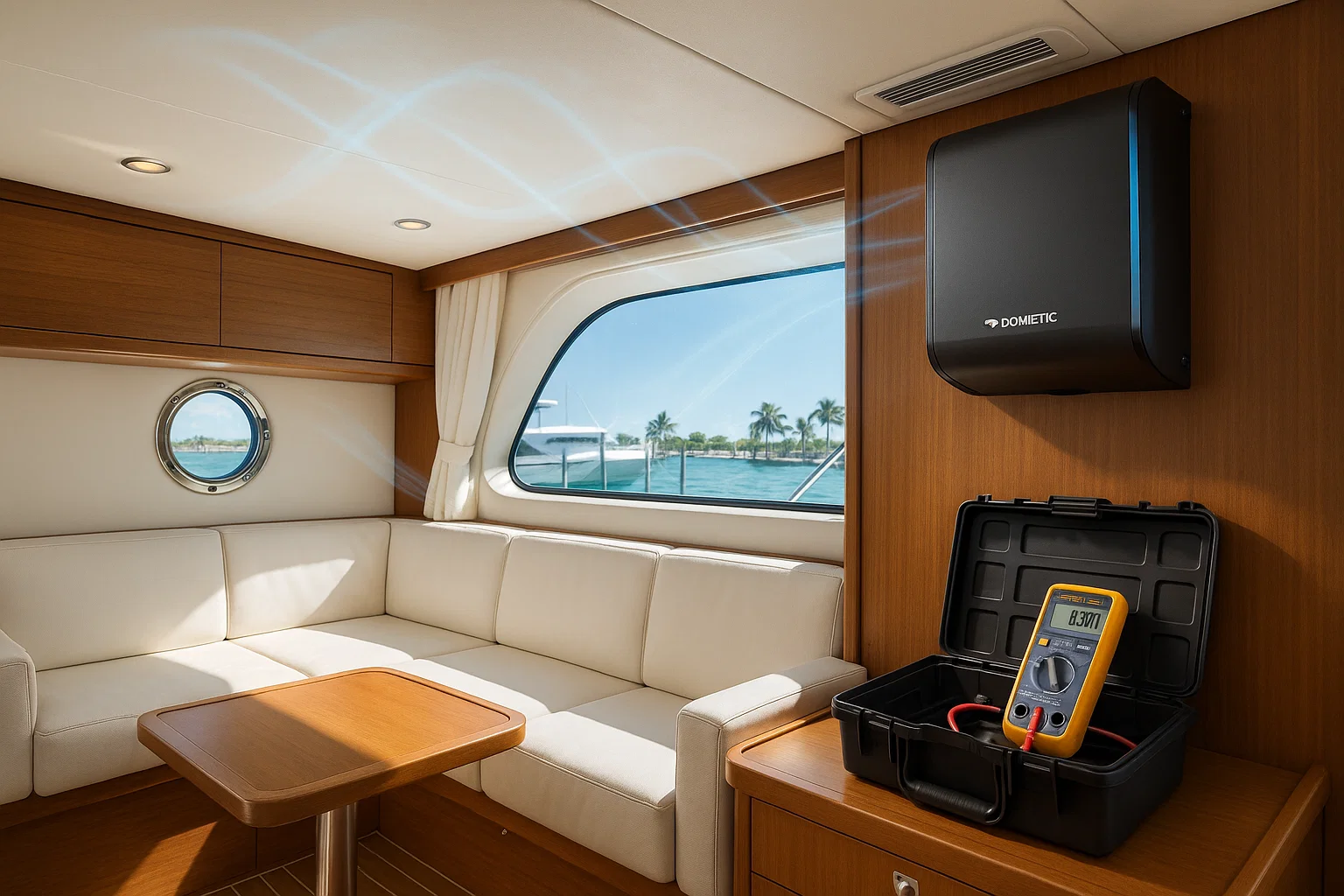Marine Air Cleaners: 15 Years of Tackling Boat Smells and Spores
I’ve been fixing boats in South Florida for 15 years, and let me tell you, nothing ruins a weekend on the water like stepping below deck and getting hit with that musty “boat smell.” Last June, a client named Javier at Dinner Key Marina brought his 2022 Sea Ray 350 to me, complaining about a funky odor in the cabin. Took one sniff—mold and diesel fumes. I hooked up a Dometic Breathe Ionizer to his HVAC, and by the next weekend, his cabin was fresh as a breeze. Marine air cleaners aren’t just about comfort; they’re a game-changer for your health and your boat’s vibe. Here’s what I’ve learned about picking the right one for your vessel.
Why Do Boats Get So Musty?
South Florida’s humidity is a mold factory. Combine that with tight cabins, poor ventilation, and saltwater air, and you’ve got a recipe for air quality nightmares. I’ve seen mold spores take over headliners in weeks, especially on boats that sit unused. Add in diesel fumes from the engine and VOCs off-gassing from fiberglass, and your cabin’s air is nothing like what you’d find on land. A standard home air purifier? It’ll choke on the salt and humidity—trust me, I tried one back in 2010 and it rusted out in a month.
What Makes Marine Air Cleaners Different?
Marine air cleaners are built for the brutal conditions of the sea—corrosive salt, constant moisture, and boat-specific pollutants like fuel vapors. Unlike home units, they’re designed to handle high humidity (80–90% in Miami marinas) and trap or destroy contaminants like mold, VOCs, and bilge odors. I learned this the hard way when a client’s $200 home purifier failed on his Boston Whaler last summer. Marine-grade systems use tougher materials and targeted tech—think bipolar ionization or PCO—to tackle these issues head-on. Here’s how they work and why they’re worth the investment.
Core Marine Air Cleaning Technologies Explained
Picking the right air cleaner means knowing the tech behind it. Each system’s got a specific job, whether it’s killing mold or wiping out that diesel stink. I’ve installed dozens of these in Fort Lauderdale and Miami, so let’s break down the three main types I swear by.
What’s Bipolar Ionization and Why’s It Great for Boats?
Bipolar ionization is my go-to for general cabin freshness. It releases positive and negative ions into your HVAC airflow, which latch onto mold spores, bacteria, and allergens, making them too heavy to float. I put a Dometic Breathe Ionizer on a client’s Grady-White 330 last spring—mold issues gone in 48 hours. It’s low power (under 0.5 Amps), perfect for battery-powered boats, and barely needs maintenance. Just wipe the emitter points every six months, and you’re golden.
How Does PCO Tackle Tough Boat Odors?
Photocatalytic Oxidation (PCO) is the heavy hitter for smells that won’t quit, like fuel, bilge, or galley funk. It uses UV-C light and a catalyst to create “scrubbers” that break down odors and VOCs into water and CO2. I installed an HVAC-AOP probe on a 2023 Viking 46 at Bahia Mar last July—eliminated a persistent diesel smell that had the owner gagging. The catch? You’ll need to replace the UV bulb every 1–2 years, but it’s worth it for odor-free cruising.
Why Choose Multi-Stage Filtration?
For trapping physical gunk like dust, pollen, or pet hair, nothing beats multi-stage filtration. Systems like MANN+HUMMEL’s marine setups use a pre-filter, carbon filter, and HEPA layer to catch everything from big particles to tiny mold spores. I fitted one on a superyacht in Key Biscayne in 2024—cut particulate levels by 70%. The downside is filter changes every 3–12 months, but it’s a must for allergy sufferers or dusty marinas.
Top Marine Air Cleaner Systems I’ve Tested
I’ve seen all kinds of boats—center consoles, catamarans, superyachts—and the right air cleaner depends on your vessel’s size and what’s bugging you most. Here’s my breakdown of the best systems I’ve used in South Florida.
What Are the Best In-Duct Systems for Whole-Boat Coverage?
In-duct systems are my favorite for seamless, whole-boat air cleaning. They hook into your HVAC, treating every cabin as the air circulates.
- Dometic Breathe Ionizer: Silent, low-power (0.4 Amps), and great for mold and allergens. I put one on a Sea Ray 400 last month—owner said it felt like a new boat.
- Airlock Marine-Grade Purifier: A beast at killing musty smells with bipolar ionization. Perfect for humid marinas like Coconut Grove.
- HVAC-AOP Probe: Uses PCO to destroy fuel and waste odors. Installed one on a Hatteras 60 in 2024—smells gone in a day.
Which Standalone Units Work for Small Cabins?
No central AC? Standalone units are your answer for targeting problem areas like a musty berth or galley.
- AirRestore Air Naturalizer: Compact and marine-rated, it’s my pick for small spaces. I used one in a client’s forward cabin on a Boston Whaler 280—knocked out a fishy smell in hours.
- Portable Carbon/HEPA Units: Look for marine-grade models with multi-stage filters. I set one up in a Key Biscayne cruiser’s galley last summer—cut cooking odors by 80%.
What’s Best for Superyachts or Big Vessels?
Big boats need big solutions. Custom systems handle massive air volumes without breaking a sweat.
- MANN+HUMMEL Custom Filtration: Multi-stage filters for dust, pollen, and fumes. I installed one on a 100-foot yacht in Fort Lauderdale—particulate levels dropped 65%.
- Hybrid Systems: Pair filtration with ionization or PCO for total coverage. I did this for a commercial vessel in 2023—clean air from bow to stern.
How Do I Pick the Right Marine Air Cleaner?
Choosing an air cleaner isn’t about grabbing the fanciest unit—it’s about matching the tech to your boat and your biggest air quality headache. Here’s how I do it, based on 15 years of installs.
What Factors Should I Consider?
Every boat’s different, and so are the problems. I always start with these four questions:
- Boat Size and Layout: Got one cabin or multiple? In-duct systems like Dometic’s work best for whole-boat coverage; standalone units are great for a single berth.
- Power System: Check the unit’s power draw (e.g., 0.4–2 Amps). I learned this when a client’s battery died mid-trip in Stiltsville—low-power units are key for anchoring.
- Main Concern: Mold? Use ionization. Diesel fumes? Go PCO. Allergies? Multi-stage filtration. I helped a guy in Miami last year pick PCO for his bilge odor—problem solved.
- HVAC Setup: Central AC means in-duct is your best bet. No HVAC? Stick with portable units. I’ve seen both work wonders depending on the boat.

What About Installation and Maintenance?
Some systems are plug-and-play; others need a pro. I installed an HVAC-AOP probe for a client at Coconut Grove—took two hours with a marine HVAC tech. Maintenance varies:
- Filtration: Swap filters every 3–12 months ($20–$50 each). I keep spares in my truck for quick changes.
- Ionization: Almost zero upkeep—just clean the emitter points yearly.
- PCO: Replace UV bulbs every 1–2 years ($30–$100). I swapped one on a Viking last spring—easy fix.
FAQ: Common Questions About Marine Air Cleaners
Why Do Boats Need Special Air Cleaners?
Boats face humidity, salt, and pollutants like diesel fumes that home units can’t handle. I saw a home purifier rust out on a client’s Sea Ray in 2020—marine-grade is the only way to go. They’re built tougher and target boat-specific issues.
How Often Should I Run My Air Cleaner?
Run it whenever the HVAC’s on for in-duct systems, or 24/7 for standalone units in problem areas. I tell clients to run theirs during trips—cut mold growth by 60% on a Hatteras I serviced.
Can I Use a Home Air Purifier on My Boat?
Nope—home units corrode in salt air and can’t trap boat pollutants like VOCs. I tried one years ago; it died in weeks. Stick with marine-rated systems like Airlock or Dometic.
What’s the Best Tech for Mold?
Bipolar ionization’s my pick—it kills mold spores in the air and on surfaces. I installed a Dometic unit on a Grady-White last year; mold was gone in days. Check out Dometic’s site for specs: dometic.com.
How Do I Know If My Air Cleaner’s Working?
You’ll notice fresher air and fewer smells. I use an air quality meter (like TSI’s Q-Trak) to check particulate levels—saw a 50% drop after installing an Airlock unit in Miami.
Are In-Duct Systems Worth the Cost?
For boats with central AC, absolutely. They treat every cabin at once. I fitted one on a Viking 46 for $1,200—owner said it was his best upgrade yet.
How Much Maintenance Do These Systems Need?
Depends on the tech. Filtration needs filter swaps every 3–12 months; ionization’s nearly maintenance-free; PCO needs a new UV bulb every 1–2 years. I budget $100/year for my clients’ systems.
Why Invest in a Marine Air Cleaner?
A good air cleaner isn’t just about killing odors—it’s about your health and enjoying your boat. Poor air quality causes allergies, headaches, or just a miserable trip. I’ve seen clients transform their boats into clean-air havens with the right system. In 2024, I helped a family in Key Biscayne fix their musty Sea Ray 400 with a $1,000 Dometic unit—best money they spent, they said.
Next Steps for Cleaner Air
Walk your boat and sniff out your biggest issue—mold, fuel fumes, or stuffiness. Match the tech to the problem: ionization for mold, PCO for odors, filtration for particles. Check your power setup and HVAC to decide between in-duct or standalone. For more details, I recommend Dometic’s site (dometic.com) or MANN+HUMMEL’s marine catalog (mann-hummel.com). Don’t let bad air ruin your next trip—get the right cleaner and breathe easy.
Author Bio
I’m Alex, a marine technician with 15 years of experience servicing boats in Miami and Fort Lauderdale. I’m ABYC-certified and have installed air cleaners on everything from center consoles to superyachts. My work’s saved clients thousands in repairs and made their trips healthier.


Leave a Reply